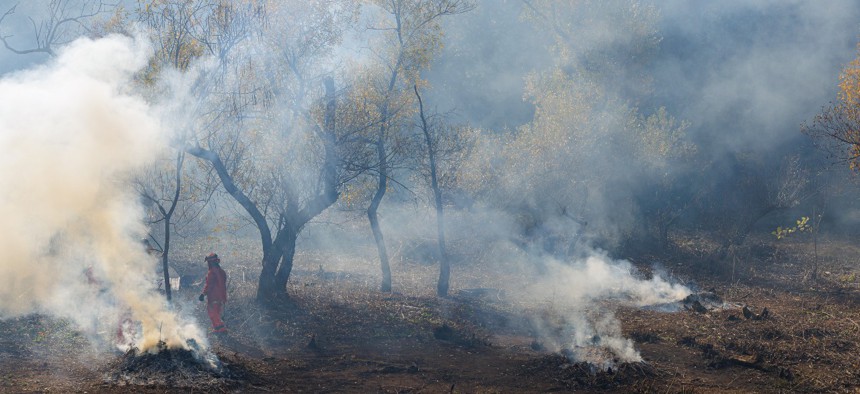
County officials said that National Environmental Policy Act, or NEPA, regulations are creating an administrative burden to their natural disaster response. Penny Collins/NurPhoto via Getty Images
Federal permitting hampers climate goals and natural disaster mitigation, counties say
Officials, who are calling for reforms, say environmental regulations shouldn’t lead to yearslong waits to build transmission lines or impede their ability to respond to natural disasters.
County officials around the country are urging the federal government to ease environmental regulations they say have made it more difficult to deal with natural disasters like wildfires and snowstorms.
Three years ago, for instance, a wildfire ravaged 85,000 acres in California’s Santa Cruz County and destroyed 900 homes. “It burned so hot that cars melted,” Matt Machado, the county’s deputy chief administrative officer, said during a discussion at the National Association of Counties’ annual conference in Washington D.C., this week. “We had trees falling all over the place.”
The county spent $9 million to remove the trees, but the Federal Emergency Management Agency rejected its request to be reimbursed because it had not fully complied with requirements under the National Environmental Policy Act, or NEPA.
“They said we didn't do the proper biological assessment, looking for frogs and salamanders. Imagine being in the middle of a wildfire,” he said. “The cars melted right to the ground. What’s living on the ground at that point?”
Agencies like FEMA, he said, are “weaponizing” NEPA regulations “to say no to these very, very large claims.”
The issue raised by counties, however, is unlikely to be addressed anytime soon. What’s more, the complex process of getting approval from federal agencies to receive funding for projects to help mitigate against future natural disasters might become even more time-consuming and costly.
That’s because of changes the White House proposed to NEPA in July 2023. While they would help in some respects, including reducing administrative burdens by limiting the length of documents, some of the changes would actually make the process even lengthier and more complicated, according to comments made by NACo to the White House Council on Environmental Quality.
The White House is proposing to remove a prohibition that bars lawsuits involving NEPA decisions unless groups and individuals had submitted comments during the decision-making process. Reversing the prohibition, NACo said, could lead to “critical infrastructure projects being held up by bad actors who bring frivolous lawsuits.”
The association urged its members to lobby against the changes during their meetings with congressional representatives this week.
Another hurdle raised during the discussion involved the complex federal permitting process and how it was impacting the nation’s transition to cleaner energy. Specifically, Sanjay Patnaik, director of the Brookings Institution’s Center on Regulation and Markets, brought up the example of transmission lines, which many counties are trying to construct to carry more electricity from solar and wind farms in rural areas to more populated urban centers.
Patnaik told county officials that attempts at permitting reform stalled at the end of 2022 and appear to remain stuck.
“The problem is that both sides don't want to compromise,” he said. “On the Democratic side, they want to have transmission lines, but they don't want to give any ground on fossil fuel infrastructure. And for the Republicans, it's kind of the opposite. They want improvements on the fossil fuel infrastructure, but not really much on the transmission line.”
Increasing the use of electricity through innovations like electric-powered cars is essential to meeting the Biden administration's goal of cutting the nation’s greenhouse emissions in half by 2030 and reaching net zero by 2050, Patnaik said.
However, it currently takes a median of nine years to get federal right-of-way permits, he said. “That’s insane.”
Rhonda Duggan, a supervisor for Mono County, California, a small rural area by the Sierra Mountains and Yosemite National Park, also described challenges dealing with NEPA laws.
Eight years ago, a “catastrophic wildfire” burned down 44 homes in a “very small but a very, very hard to access area,” she said. The county has wanted to convert what’s now a private dirt road into an emergency escape route in the event of another fire. But Duggan said it has been very challenging to get through the NEPA process.
“Lives are at stake,” she said. “That's where working to get the process streamlined will help.”
Kery Murakami is a senior reporter for Route Fifty, covering Congress and federal policy. He can be reached at kmurakami@govexec.com. Follow @Kery_Murakami
NEXT STORY: Amid budget squeeze, FLRA panel regs encourage electronic documents filing







